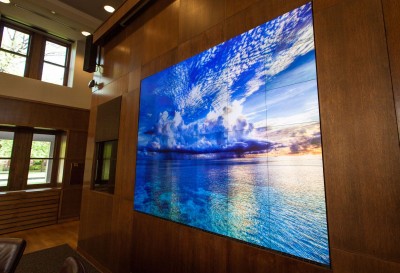By Peter Saunders
Video walls are quickly becoming commonplace in the digital signage industry. Their popularity in airports, restaurants, shopping malls, hotels, sports bars, exhibitions and other high-traffic environments is causing a jump in digital signage hardware sales. According to iSuppli, a market research firm, global sales of flat-panel displays specifically for video wall installations are experiencing a compound annual growth rate (CAGR) of 55.2 per cent, with close to 500,000 expected to be in use in 2014.
“There will be an approximately fourfold increase in the next few years,” says Jonathan Brawn, principal and co-owner of Brawn Consulting, which advises manufacturers, distributors, consultants and dealers in the professional AV industry.
A larger display area tends to draw and retain a larger audience. Multiple content sources can be used simultaneously. And higher aggregate displayed resolution provides the ability to deliver more detailed content than a single digital projector, for example, could throw onto a blank wall.
“Video walls can be more cost-effective than projections,” says Brawn. “Front-projection applications make up some 30 per cent of all digital signage, but they are more difficult to design, as the image’s appearance is more sensitive to lensing, lumen output, calibration, edge blending, viewing angles, ambient light and positioning. It takes more time to install when you have to deal with those environmental issues.”
As more video walls go up, some installations are using creative approaches to stand out, including unusual shapes and more immersive configurations. In this competitive and growing market, it is important for audiovisual (AV) integrators and other professionals in the industry to learn about various related technologies, from the screens themselves to options in hardware- and software-based processing.

As more video walls are installed indoors, it is important to choose and calibrate screens so they do not appear too bright.
“With today’s demand for higher pixel densities and capabilities for manipulating content from multiple sources, we need to make sure professionals understand these systems,” says Brawn. “Interest will only increase.”
From analogue to digital
The traditional definition of a video wall is a tiled display matrix. The tighter the tiling, the more clearly the displays will form a single wall.
Video walls in the early 1980s were built by mounting cathode ray tube (CRT) televisions (TVs) in a grid formation. These were typically 711-mm (28-in.) screens, with large gaps between sections. With each display hard-wired to a single content source, display options were limited.
“It was difficult to split a single input video signal to produce a large image across 16 monitors in a 4 x 4 array,” says Jeff Greenberg, CEO of Hiperwall, which develops video wall software.






